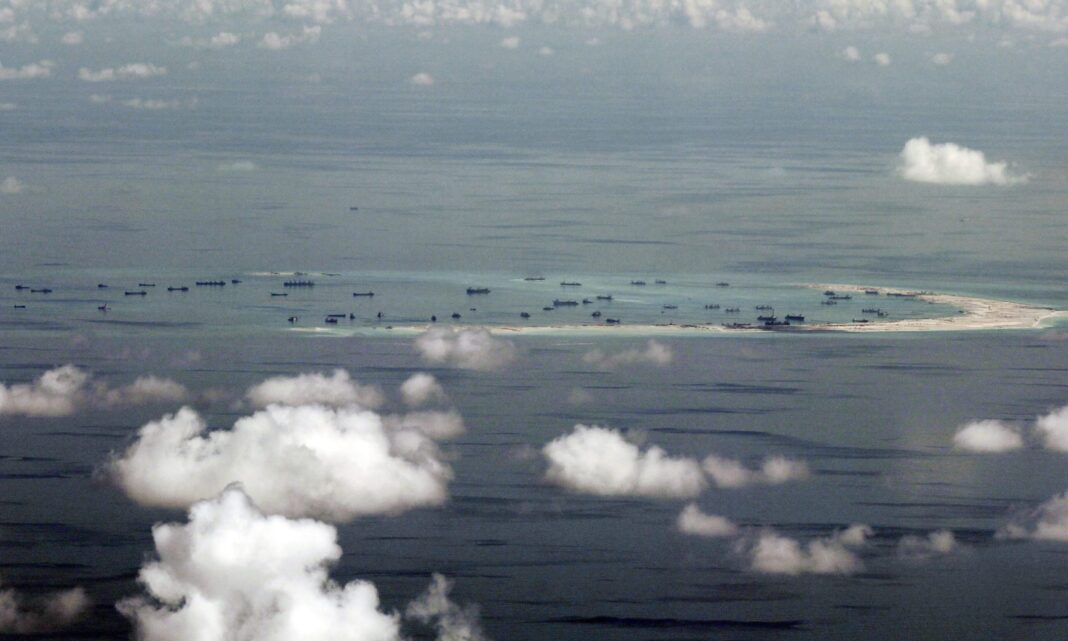In the last decade the international community has witnessed a growing frequency in the use of asymmetric / unconventional warfare. The Chinese activism on the South China Sea and the Russian aggression in Crimea illustrate the practical utilization of the novel concepts of warfare.
First, I will elaborate on the conceptual and interpretative framework of the new warfare methods, which will be followed by the analysis of the 2014 Russian actions in the Crimean Peninsula and the observed Chinese activism in the South China Sea. I aim to draw parallel between these two strategies. Familiarising with new warfare methods are indispensable, nothing shows more sharply than the paralysed western reactions after the Russian actions in 2014.
Clarifying the notions
The need for change of conventional warfare methods have occurred near the end of the Cold War. The fourth generation of warfare was created this time. It differs from the basic notion of warfare in the terms of the blurring distinction of peace and war, the NGOs participation in the fight. The difference is fading away between the civil and military sphere and the image of fronts has also become hard to determine. Battles are not only fought in battlespaces but in highly populated urban centres and in cyberspace parallelly. Searching for weak spots of the enemy, blocking surveillance and sabotaging intelligence gathering have become the ordinary method of waging wars. In order to destroy the enemy?s political will in this asymmetric warfare, the weaker parties try to implement conventional and non-conventional military means at the same time. Behind this sort of strategy stands the idea that with a higher level of political will, there is a chance to beat a foe with higher military and economic capabilities. In this case, the weaker party instead of initiating direct attacks against the enemy, it combines guerrilla tactic with soft social, economic and cultural means while using disinformation and political campaigns with a goal to directly attack the political will of the enemy.
At the beginning of the 21th century, new conception started to emerge in the realm of the hybrid warfare and was used to describe the Chechen wars. The hybrid warfare notion is similar to fourth generation warfare in the sense that the borders are diminishing: belligerents simultaneously deploy regular and irregular forces, terrorists, criminal organisations in order to achieve political and military objectives. Frank Hoffman differentiates this concept from the guerrilla warfare by underlining the multimodality of hybrid warfare while emphasizing that the former?s goal is to prolong conflicts, while the latter has the ability of fast winning.
Contemporary experts use hybrid warfare to describe what happened between Russia and Ukraine however, there is plenty of uncertainty and disagreement. Some call it as Gray zone war emphasizing the complex and indirect nature of it while underline the undefinable character as it is hard to decide what is the best way to describe the conflict; it could be interstate aggression, civil war or interstate conflict.[1]
Applying what happened in the Crimea to the South China Sea, would present helpful lessons. The invasion of 2014 took place with rapidity, minimal resistance and with full foreign obscureness. Russia seized important maritime infrastructures by which it was easy to adopt a stable sea line of communications (SCLOs) while using high-end technologies to disrupt Western observers.
International status of the South China Sea
After tossing white sand on some atolls, China started swiftly building operations on those newly regained islands. The Chinese claim of the territory is attempting to take advantage of the fishery and of the raw material deposits. Since the enormous volume of the international trade happening here (30% of the world trade flow), this region has an immense importance.
China is using its fishermen as proxies to strengthen its sovereignty while building non-civilian infrastructures. Inside China there is a growing demand for a rather assertive foreign policy. To fulfil these demands, Beijing started to progressively defend the interests of its fishermen. Time to time Chinese vessels engage to protect their citizens? businesses from other countries. Similar approach is observable when it attempts to initiate drilling processes, reconnaissance actions and to prevent such actions from adversaries. ?Little blue men? appear to help blurring the borderlines of civilian and martial as such. From time to time, paramilitary units are participating hand in hand with Chinese authorities, sometimes they pretending to be ordinary fishermen. These ?little blue men? appear to help blurring the borderlines of civilian and martial as such.
Due to the ongoing territorial dispute, Philippines appealed to the Permanent Court of Arbitration against China in 2016, which decided in favour of the former. China bases its claims on historical rights, which the Court rejected. It labelled the island constructions illegal due to their detrimental effects on the environment. China did not accept the judgment while the United States has to enforce international law and the principle of free navigation.
Island chain obstacle
It is important to understand how China sees its impending challenges on the sea. In the past decades there is a will to turn itself towards the maritime domains. This intention could generate claustrophobic sentiments in Chinese decisionmakers because of the position of the first island chain encircling mainland China. Most of the literature agrees on that the line stretches from Japan, through Ryukyu islands, touching Taiwan and reaching the Philippines. Despite the notion came from Chinese experts, it is wide-spread among Western terminology as well. Bernard Cole noted that while China turns its attention to the seas, focusing on the chain, contains deeply continental logic as the country determines itself focused on points of the space rather than following the logic of sailor who thinks beyond the direct natural barriers. Drawing lines arbitrarily decreasing the fleet?s manoeuvrability and flexibility. Thanks to the soviet help in building the Chinese navy, and to the Chinese historical reflexes, this kind of thinking marks that the Chinese strategists significantly incorporate land into maritime strategy, Cole says. As Beijing declares these territories as its own defence line, friction is projected in the region.
Taking into consideration that while China is pivoting towards the seas, its main political and economic centrums are located in the coastline. Despite the country?s immerse extent, it has no strategic depth where it can retreat to reorganise itself after an attack from the sea which explains its intention to pivot to maritime domains. [2]
Operational ideas concerning the artificial islands
The primary goal of China in the Spratly-islands is not power projection but gathering information, obstructing enemy intelligence while strengthening its leadership, communication, surveillance and reconnaissance capabilities. By contrast to the Western thinking, which focuses on the application of conventional kinetical weaponry of the islands, the Chinese concept rather tries to use them to wage information warfare. Fire power, manoeuvrability and high range precision rocket systems are valuable assets for China, however, reaching the information superiority is more desirable. This superiority means an increasingly extended surveillance over the battleground meanwhile obstructing the same capability from the enemy. China created AEZ (air exclusion zone) in the international waters. The goal is to impede the US. Navy in its firepower and manoeuvrability in order to protect valuable Chinese targets.
The PLAN?s (People’s Liberation Army) strategy is active defence, which is strategically defensive while on operational level has offensive means. Towers built on the islands facilitate the creation of communication networks covering the disputed area. Real time imagery enables the usage of higher range weapon systems from the continent or vessels under and above the water, maybe from aircraft carriers. Information superiority can prompt enemy fleets to function on power save mode switching off radar systems in order to avoid being detected. Many islands are capable of launching surveillance aircrafts (such as KJ-500 early detection aircraft) planes that can operate in high security while establishing real-time monitoring thanks to the ?bubble? made by surface-to-air missile systems located in those islands.
The coastal guards and the fishermen?s boats do not possess highly sophisticated communications capabilities and they are not military personnel, still the PLAN employs them to get intelligence, to attack other countries? fishermen with the chance of plausible deniability. This kind of economic activity is similar to what is observed in the case of Svalbard, where Russian presence has only one purpose: to demonstrate that they are players in that territory.
Utilising Anti-Access/Area Denial in order to achieve maritime security is not only resourceful for operational means, but it can make the regional Western allies uncertain concerning American potency. The artificial islands operate the same way as the Russian Bastion conception in defending the Kola-peninsula and its nuclear arsenals.
In a high intensity conflict, these islands can easily become from unsinkable carriers to immobile targets. Concerning that the Chinese navy has only participated in UN peacekeeping missions, their operational efficiency is debatable. Inasmuch as Chinese strategy generates aversions in the region, a country which has fought desperate battles against the US, started getting closer to Washington. The example of Vietnam could raise concerns in Beijing. The Russians were effective in the case of Crimea in the terms of reconciliation with regional players in order to avoid their more assertive response. China has a strategy beyond the conventional model which manifested in the three modes of warfare: psychological warfare, opinion warfare with the help of disinformation, legal warfare (lawfare) by taking advantage of the holes of international law and norms.
Capturing local islands are different from the case of Crimea because these islands are mostly uninhabited or barely count as islands legally therefore the information warfare is not targeting population of the islands but the inhabitants of the contenders and China?s public opinion.
Conclusion
Since Russia and China are nuclear powers and nuclear arsenals have defensive characteristics, they have to create an international environment where the annexing party is becoming the defensive participant by fast and decisive occupation. By this method, a new fait accompli situation emerges and through achieving a new status quo, the original defender has to react. Via this rapid game-changing move, the deterrence of nuclear warheads and anti-access- area denial (A2/D2) systems are becoming crucial factors to preserve the new status.
The invasion of the Crimea and the beginning of the assertive Chinese maritime activity with high resemblance and same goals in the South China Sea occurred at the same time. These goals are in collusion with the international law therefore they contribute to the erosion of legal obligations. If the western doctrines ? which are using conventional solutions ? could not adapt effectively to the contemporary needs, then emerging adversaries could copy Russian and Chinese methods with success resulting a more and more instable world.
Written by: Zoltán Bán
Bibliography:
[1] Laura Maria Herta, ?Hybrid Warfare ? A Form of Asymmetric Conflict,? International Conference Knowledge-Based Organization Vol. XXIII, no. 1 (2017): 135-143. doi: 10.1515/kbo-2017-0021
[2] Toshi Yoshihara, ?China’s Vision of Its Seascape: The First Island Chain and Chinese Seapower? Asian Politics & Policy 4, no.3 (2012): 293-314 doi: 10.1111/j.1943-0787.2012.01349.x
Cover: Constuctions on South-China Sea. 11.05.2015. Aerial view of a Chinese construction site on the Spratly Islands in the South China Sea on 11 May 2015. China is working hard on the almost scratchy artificial sand islands, although China and surrounding countries have been arguing for years about the area?s affiliation. (Source: MTI/EPA/Pool/Ritchie B. Tongo)
Címlapkép: Építkezések a Dél-kínai-tengeren. Spratly-szigetek, 2015. május 11.
Légi felvétel a Dél-kínai-tengeren fekvő Spratly-szigeteknél folyó kínai építkezésr?l 2015. május 11-én. Kína nagy erőkkel dolgozik a szinte a semmiből emelt mesterséges homokszigeteken, jóllehet Kína és a környező országok évek óta vitatkoznak a terület hovatartozása miatt. (Forrás: MTI/EPA/Pool/Ritchie B. Tongo)











